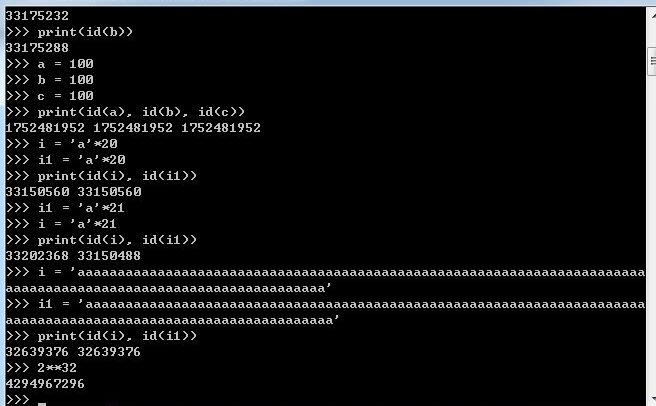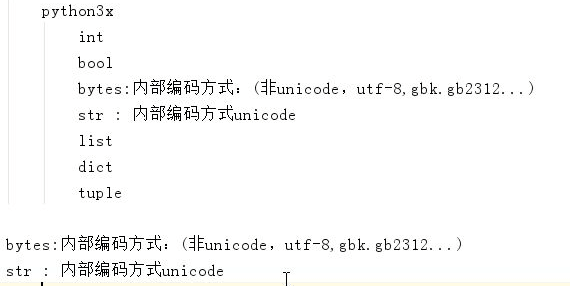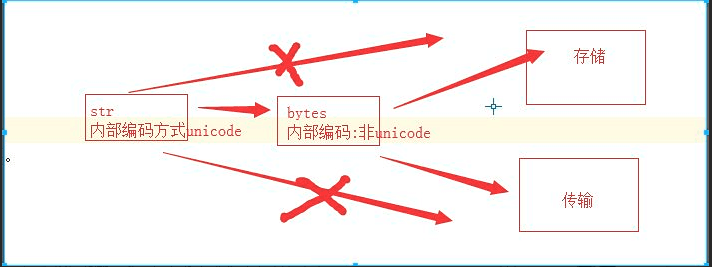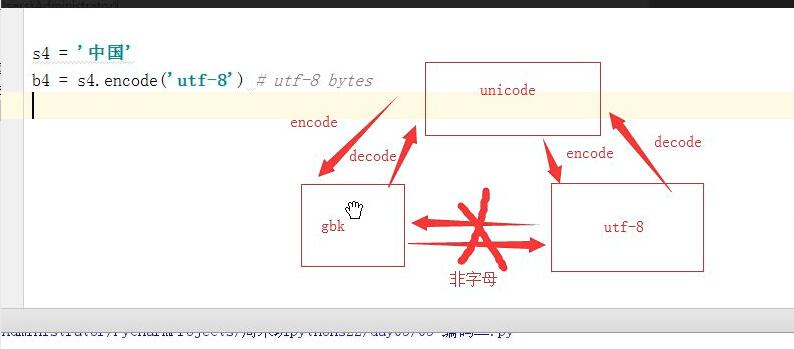本节内容:集合、深浅copy、文件操作、函数初识
1.小知识点补充
2.编码二
3.集合
4.深浅copy
5.文件操作
6.函数的初识
1、小知识点补充
1.1 小数据池====str、int
小数据池存在的意义就是节省内存
节省内存,位多个变量开辟一个共享空间(str和int)
int:-5--256

int======>他们公用一个内存
字符串的内存换位的条件
1、不能含有特殊字符
2、单个元素*int不能超过21

2、编码二
2.1 二进制和程序的对照关系
ascii:数字、字母、特殊字符
字节:8位表示一个字节
字符: 你看到的最小单位
abc: a就是一个字符
中国: "中"就是一个字符
a:0000 1011

1、 不同编码之间的二进制对应关系互不通用,不能互相识别(对应的密码本不一样)
2、对于文件的存储和传输不能使用unicode(太占内存)
2.2 数据类型
=======python 3版本 str bool int dist tuple list ======


字符串的存储过程(unicode=====>非unicode====>存储/传输)
bytes:内部编码方式:(非unicode,utf-8,gbk.gb2312...)
str : 内部编码方式unicode
字母:
str:表现形式:s1 = 'alex'
内部编码:unicode
bytes:表现形式:s2 = b'alex'
内部编码:非unicode
中文:
str:表现形式:s1 = '中国'
内部编码:unicode
bytes:表现形式:b1 = b'xe4xb8xadxe5x9bxbd'
内部编码:非unicode
bytes 虽然具有str 类型所有的功能特性,但是bytes 处理中文展示的时候,是我们看不懂的,
所以这也是str还存在的意义下面是str和bytes 类型转化:
1.encode编码

s1 = 'alex' b1 = s1.encode('utf-8') print(b1) ===》输出 b'alex' b2 = s1.encode('gbk') print(b2) ===》输出 b'alex'
2.decode 解码(你用什么方式编码的那么就是相应的方式解码)

s1 = 'alex' # str ---> bytes encode 编码 b1 = s1.encode('utf-8') print(b1) #bytes---> str decode 解码 s2 = b1.decode('utf-8') print(s2) ===》输出 b'alex' alex s1 = 'alex' b2 = s1.encode('gbk') s3 = b2.decode('gbk') print(b2) print(s3) ===>输出 b'alex' alex
【注意】utf-8和gbk 的英文部分引用的是ascall 码,在做英文的转化的时候可以混用(强烈不推荐),
但是在设计英文意外的数据类型的时候就会报错了具体展示如下:

s1 = 'alex' b1 = s1.encode('utf-8') s2 = b1.decode('gbk') print(s2) ===》输出 alex s4 = '中国' b4 = s4.encode('utf-8') print(b4) ===》输出 b'xe4xb8xadxe5x9bxbd' s5 = b4.decode('gbk') print(s5) ===》输出 直接报错
考题:如何将代码中的utf-8=====>转化成gbk的代码格式


s4 = '中国' b4 = s4.encode('utf-8') # utf-8 bytes print(b4) b6 = b4.decode('utf-8').encode('gbk') print(b6) ===》输出 b'xe4xb8xadxe5x9bxbd' b'xd6xd0xb9xfa'
3.集合
集合是无序的,不重复的数据集合,它里面的元素是可哈希的(不可变类型),但是集合本身是不可哈希(所以集合做不了字典的键)的。
以下是集合最重要的两点:
1、去重,把一个列表变成集合,就自动去重了。
2、关系测试,测试两组数据之前的交集、差集、并集等关系。

set1 = {'alex', 'wusir', 'taibai', 'alex'}
set2 = {'alex', 'wusir', 'taibai', 'alex',[1, 2, 3]}
print(set1)
print(set2)
===》输出
{'alex', 'taibai', 'wusir'}#去重
===》输出
set2报错
3.1 列表的去重:set
l1 = [1, 1, 2, 2, 3, 4, 4, 5]
print(list(set(l1)))
=====>输出
[1, 2, 3, 4, 5]
3.2 集合的增

set1 = {'alex', 'wusir', 'ritian', 'egon', 'barry'}
set1.add('文周')
print(set1)
===》输出
{'ritian', 'alex', 'egon', 'barry', 'wusir', '文周'}
set1.update('abc')
print(set1)
===》输出
{'b', 'egon', 'ritian', 'c', 'barry', 'wusir', 'a', 'alex'}
3.3 集合的删

set1 = {'alex', 'wusir', 'ritian', 'egon', 'barry'}
set1.pop() #随机删除
print(set1)
===》输出
{'barry', 'ritian', 'egon', 'alex'}
set1.remove('alex') # 按照元素删除
set1.remove('alex1') # 按照元素删除,没有会报错
print(set1)
===》输出
{'wusir', 'egon', 'barry', 'ritian'}
set1.clear() #清空
print(set1) # set()
===》输出
set()
del set1 #删除列表
print(set1)
=====》输出
报错
3.4 集合的查

set1 = {'alex', 'wusir', 'ritian', 'egon', 'barry'}
for i in set1:
print(i)
====》输出
ritian
wusir
barry
egon
alex
3.5 集合的其他操作
3.5.1 交集(& 或者 intersection)

set1 = {1, 2, 3, 4, 5}
set2 = {4, 5, 6, 7, 8}
print(set1 & set2)
print(set1.intersection(set2))
====>输出
{4, 5}
{4, 5}
3.5.2 并集(|或者union)

set1 = {1, 2, 3, 4, 5}
set2 = {4, 5, 6, 7, 8}
print(set1 | set2)
print(set1.union(set2))
====>输出
{1, 2, 3, 4, 5, 6, 7, 8}
{1, 2, 3, 4, 5, 6, 7, 8}
3.5.3 差集(-或者difference)

set1 = {1, 2, 3, 4, 5}
set2 = {4, 5, 6, 7, 8}
print(set1 - set2)
print(set1.difference(set2))
print(set2 - set1)
====》输出
{1, 2, 3}
{1, 2, 3}
{8, 6, 7}
3.5.4 反交集(^ 或者 symmetric_difference)

set1 = {1,2,3,4,5}
set2 = {4,5,6,7,8}
print(set1 ^ set2) ===》# {1, 2, 3, 6, 7, 8}
print(set1.symmetric_difference(set2))===》# {1, 2, 3, 6, 7, 8}
3.5.5 子集与超集

set1 = {1,2,3}
set2 = {1,2,3,4,5,6}
print(set1 < set2)
print(set1.issubset(set2)) # 这两个相同,都是说明set1是set2子集。
====》输出
True
True
print(set2 > set1)
print(set2.issuperset(set1)) # 这两个相同,都是说明set2是set1超集。
====》输出
True
True
3.5.6 frozenset不可变集合,让集合变成不可变类型。
set1 = {1, 2, 3}
print(frozenset(set1))
====》输出
frozenset({1, 2, 3})
4.深浅copy
4.1 赋值运算补充,赋值运算中公用一个内存空间
s1 = [1, 2, 3] s2 = s1 # 共用一个 s1.append(666) print(s1, s2) ====>输出 [1, 2, 3, 666] [1, 2, 3, 666]

4.2 浅拷贝copy。

s1 = [1, 2, 3] s2 = s1.copy() s1.append(666) print(s1, s2) ====》输出 [1, 2, 3, 666] [1, 2, 3] s1 = [1, 2, 3,[11,22]] s2 = s1.copy() s1[-1].append(666) print(s1, s2) #[1, 2, 3, [11, 22, 666]] [1, 2, 3, [11, 22, 666]] print(id(s1), id(s2)) #38526216 38526920 print(id(s1[-1]), id(s2[-1])) #38526856 38526856 # 浅copy 第一层各自独立,从第二层开始,共用一个内存地址。
对于浅copy来说,第一层创建的是新的内存地址,而从第二层开始,指向的都是同一个内存地址,所以,对于第二层以及更深的层数来说,保持一致性。
4.3 深拷贝deepcopy。

import copy s1 = [1, 2, 3,[11,22]] s2 = copy.deepcopy(s1) s1.append(666) print(s1, s2) ====》输出 [1, 2, 3, [11, 22], 666] [1, 2, 3, [11, 22]] s1 = [1, 2, 3,[11,22]] s2 = copy.deepcopy(s1) s1[-1].append(666) print(s1, s2) ====》输出 [1, 2, 3, [11, 22, 666]] [1, 2, 3, [11, 22]]
对于深copy来说,两个是完全独立的,改变任意一个的任何元素(无论多少层),另一个绝对不改变。
4.4 切片 浅copy
s1 = [1, 2, 3, [11, 22]] s2 = s1[:] # s1.append(666) s1[-1].append(666) print(s1, s2) ====>输出 [1, 2, 3, [11, 22, 666]] [1, 2, 3, [11, 22, 666]]
5.文件操作
计算机系统分为:计算机硬件,操作系统,应用程序三部分。
我们用python或其他语言编写的应用程序若想要把数据永久保存下来,必须要保存于硬盘中,这就涉及
到应用程序要操作硬件,众所周知,应用程序是无法直接操作硬件的,这就用到了操作系统。操作系统
把复杂的硬件操作封装成简单的接口给用户/应用程序使用,其中文件就是操作系统提供给应用程序来操
作硬盘虚拟概念,用户或应用程序通过操作文件,可以将自己的数据永久保存下来。
有了文件的概念,我们无需再去考虑操作硬盘的细节,只需要关注操作文件的流程:

f1 = open(r'd:/a.txt', encoding='gbk', mode='r') print(f1.read()) f1.close() f1 = open('log1', encoding='gbk', mode='r') print(f1.read()) f1.close() """ f1 文件句柄,f,file,file_hander,f_h.... open()调用的内置函数,内置函数调用的系统内部的open, 一切对文件进行的操作都是基于文件句柄f1. 执行流程: 1,打开文件,产生文件句柄。 f=open('a.txt','r',encoding='utf-8') #默认打开模式就为r 2,对文件句柄进行操作。 data=f.read() 3,关闭文件句柄。 f.close()
5.1 常见报错


5.2 读 r
5.2.1 read() 全部读出来
f1 = open('log1', encoding='utf-8') content = f1.read() print(content) f1.close()
5.2.2 read(n) 读一部分
f1 = open('log1', encoding='utf-8') content = f1.read(3) print(content) f1.close()
5.2.3 rb模式
r 模式 read(n) n 按照字符读取。
rb 模式 read(n) n 按照字节读取。
f1 = open('log1', mode='rb') print(f1.read(3).decode('utf-8')) f1.close()
5.2.4 readline() 按行读取
f1 = open('log1', encoding='utf-8') print(f1.readline()) print(f1.readline()) print(f1.readline()) f1.close()
5.2.5 readlines()多行读取
f1 = open('log1', encoding='utf-8') print(f1.readlines()) f1.close()
5.2.6 for 循环
f1 = open('log1', encoding='utf-8') for line in f1: print(line) f1.close()
5.2.7 r+ 读写 先读后写
f1 = open('log1', encoding='utf-8', mode='r+') # print(f1.read()) # f1.write('666') f1.write('a') print(f1.read()) f1.close()
5.3 写 w
w 没有文件,新建文件写入内容
有原文件,先清空内容,在写入新内容。

f1 = open('log2', encoding='utf-8', mode='w') f1.write('桃白白fdksagdfsa') f1.close() #图片的读取及写入 f1 = open('1.jpg', mode='rb') content = f1.read() f2 = open('2.jpg', mode='wb') f2.write(content) f1.close() f2.close()
5.3.1 w+先写后读
f1 = open('log2', encoding='utf-8', mode='w+') f1.write('两款发动机了') f1.seek(0) print(f1.read()) f1.close()
5.4 追加 a
a没有文件,新建文件写入内容
f1 = open('log3', encoding='utf-8', mode='a') # f1.write('alex 666') f1.write(' alex 666') f1.close()
5.4.1 a+

f1 = open('log3', encoding='utf-8', mode='a') # f1.write('alex 666') f1.write(' alex 666') f1.close() #在后面追加
5.5 其他操作方法

readable 是否可读 writable 是否可写 f1.seek(12) # 任意调整 f1.seek(0,2) #光标调整到最后 f1.seek(0) #光标调整到开头 f1.tell() # 告诉光标的位置 f1.truncate(3) # 按照字节对原文件进行截取 必须在a 或 a+ 模式 ====================== f1 = open('log3', encoding='utf-8', mode='a+') # f1.write('python22期') # print(f1.read()) print(f1.readable()) print(f1.writable()) f1.close() ====================== f1 = open('log2', encoding='utf-8') f1.read() print(f1.tell()) print(f1.seek(0)) print(f1.seek(0,2)) f1.seek(12) # 任意调整 f1.seek(0,2) #光标调整到最后 f1.seek(0) #光标调整到开头 print(f1.tell()) # 告诉光标的位置 f1.close() ======================= f1 = open('log3', encoding='utf-8', mode='a+') f1.truncate(3) # 按照字节对原文件进行截取 必须在a 或 a+ 模式 f1.close()
5.6 不用主动关闭文件句柄

with open('log1', encoding='utf-8') as f1, open('log2', encoding='utf-8', mode='w') as f2: content = f1.read() f2.write(content) with open('log1', encoding='utf-8') as f1: print(f1.read()) f1.close() pass with open('log1', encoding='utf-8',mode='w') as f2: f2.write('666')
5.7 文件的改

# 1,以读模式打开原文件。 # 2,以写的模式打开一个新文件。 #3,将原文件读出按照要求修改将修改后的内容写入新文件。 import os with open('file', encoding='utf-8') as f1, open('file.bak', encoding='utf-8', mode='w') as f2: old_content = f1.read() new_content = old_content.replace('alex', 'SB') f2.write(new_content) os.remove('file') os.rename('file.bak', 'file') #4,删除原文件。 # 5,将新文件重命名原文件。
5.8 升级版本

import os with open('file', encoding='utf-8') as f1, open('file.bak', encoding='utf-8', mode='w') as f2: for line in f1: new_line = line.replace('SB','alex') f2.write(new_line) os.remove('file') os.rename('file.bak', 'file') with open('log1', encoding='utf-8', mode='w') as f1: f1.write('111') f1.write('666') f1.write('333') f1.write('222')
6.函数的初识
6.1 什么是函数
先思考一个问题:
现在有这么个情况:python中的len方法不让用了,你怎么办?
来测试一下‘hello word’ 的长度:

s = 'hello world' count = 0 for i in s: count += 1 print(count) =========== l1 = [1, 2, 3, 4, 5, 6] count = 0 for i in l1: count += 1 print(count) ===========
函数是组织好的,可重复使用的,用来实现单一,或相关联功能的代码段。
函数能提高应用的模块性,和代码的重复利用率。你已经知道Python提供了许多内建函数,比如
print(),len()等。但你也可以自己创建函数,这被叫做用户自定义函数。
6.2 函数的定义与调用

s = 'lkfjsjulkjdgjdsf' def my_len(): count = 0 for i in s: count += 1 print(count) ''' def 关键字 函数名(): 函数体 函数执行:函数名() 函数:以功能为导向。 ''' my_len()
关于def

定义:def 关键词开头,空格之后接函数名称和圆括号(),最后还有一个":"。 def 是固定的,不能变,他就是定义函数的关键字。 空格 为了将def关键字和函数名分开,必须空(四声),当然你可以空2格、3格或者你想空多少都行,但正常人还是空1格。 函数名:函数名只能包含字符串、下划线和数字且不能以数字开头。虽然函数名可以随便起,但我们给函数起名字还是要尽量简短,并能表达函数功能 括号:是必须加的,先别问为啥要有括号,总之加上括号就对了! 注释:每一个函数都应该对功能和参数进行相应的说明,应该写在函数下面第一行。以增强代码的可读性。 调用:就是 函数名() 要记得加上括号。
6.3 return
1,终止函数。
2,给函数的执行者返回值。
6.3.1 没有返回值
不写return的情况下,会默认返回一个None:我们写的第一个函数,就没有写return,这就是没有返回值的一种情况。

#函数定义 def mylen(): """计算s1的长度""" s1 = "hello world" length = 0 for i in s1: length = length+1 print(length) #函数调用 str_len = mylen() #因为没有返回值,此时的str_len为None print('str_len : %s'%str_len)
只写return,后面不写其他内容,也会返回None。

def ret_demo(): print(111) return print(222) ret = ret_demo() print(ret)
6.3.2 返回一个值

#函数定义 def mylen(): """计算s1的长度""" s1 = "hello world" length = 0 for i in s1: length = length+1 return length #函数调用 str_len = mylen() print('str_len : %s'%str_len)
6.3.3 返回多个值

def ret_demo1(): '''返回多个值''' return 1,2,3,4 def ret_demo2(): '''返回多个任意类型的值''' return 1,['a','b'],3,4 ret1 = ret_demo1() print(ret1) ret2 = ret_demo2() print(ret2) 返回多个值
返回的多个值会被组织成元组被返回,也可以用多个值来接收。

def ret_demo2(): return 1,['a','b'],3,4 #返回多个值,用一个变量接收 ret2 = ret_demo2() print(ret2) #返回多个值,用多个变量接收 a,b,c,d = ret_demo2() print(a,b,c,d) #用多个值接收返回值:返回几个值,就用几个变量接收 a,b,c,d = ret_demo2() print(a,b,c,d)
6.4 函数的参数

#函数定义 def mylen(s1): """计算s1的长度""" length = 0 for i in s1: length = length+1 return length #函数调用 str_len = mylen("hello world") print('str_len : %s'%str_len)
实参与形参
参数还有分别:
我们调用函数时传递的这个“hello world”被称为实际参数,因为这个是实际的要交给函数的内容,简称实参。
定义函数时的s1,只是一个变量的名字,被称为形式参数,因为在定义函数的时候它只是一个形式,表示这里有一个参数,简称形参。
6.4.1 实参角度

#位置参数 按照顺序一一对应 def func1(a, b, c): print(a, b, c) func1(1, 2, 'alex') def max(a, b): return a if a > b else b ret = 1 if 2 > 1 else 6 print(ret) print(max(10, 2)) #关键字传参 一一对应。 def func2(a, b): print(a, b) func2(b=2, a=3) #混合参数。(位置参数,关键字参数) 关键字参数必须在位置参数后面。 def func3(a, b, c, d): print(a, b, c, d) func3(1,2,d=3,c=5)
6.4.2 形参角度

#位置参数。按顺序一一对应。 def func1(a, b, c): print(a, b, c) func1(1, 2, 'alex') #默认参数。 默认参数在位置参数的后面。 def func1(): print(a, b, c) func1(1, 2, 'alex') def login(name,sex='男'): with open('register', encoding='utf-8', mode='a') as f1: f1.write('{},{} '.format(name,sex)) while True: name = input('请输入姓名:').strip() if '1' in name: login(name) else: sex = input('请输入性别:').strip() login(name,sex) #动态参数。 *args, **kwargs 万能参数。 args:所有的位置参数,放在一个元组中。 kwargs:所有的关键字参数,放在一个字典中。 def func3(*args, **kwargs): #函数的定义的时候 * 代表聚合。 print(args) print(kwargs) # func3(1, 2, 3, 'alex', c=6, name='wusir', age='21') # func3(*[1, 2, 3],*(22, 33)) #函数的执行的时候 * 代表打散。 func3(**{'name':"alex"},**{'age':23}) #函数的执行的时候 * 代表打散。 func3(1, 2, 3, 22, 33) #函数的执行的时候 * 代表打散。 #形参的顺序 位置参数 *args, 默认参数,**kwargs def func5(a,b,*args,sex='男',**kwargs): print(a,b,) print(args) print(sex) print(kwargs)
